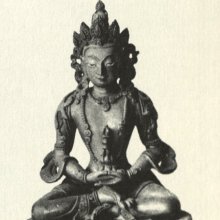Bhadrapala, Bhadrapāla: 8 definitions
Introduction:
Bhadrapala means something in Buddhism, Pali, Hinduism, Sanskrit. If you want to know the exact meaning, history, etymology or English translation of this term then check out the descriptions on this page. Add your comment or reference to a book if you want to contribute to this summary article.
Images (photo gallery)
In Buddhism
Tibetan Buddhism (Vajrayana or tantric Buddhism)
Source: Wisdom Library: MañjuśrīnāmasaṃgītiBhadrapāla (भद्रपाल) is one of the sixteen bodhisattvas appearing in the Vajradhātu-mahāmaṇḍala, according to the Nāmamantrārthāvalokinī v5.38-41. The Nāmamantrārthāvalokinī (literally, ‘an explanation of the nāma-mantras’) is a commentary (ṭīkā) on the 8th century Mañjuśrīnāmasaṃgīti.
Bhadrapāla is a name of Mañjuśrī (the embodiement of non-dual knowledge) and, together with other names, forms the core essence of the Mañjuśrīnāmasaṃgīti. The Nāmamantrārthāvalokinī provides the practitioner a sādhana (‘meditative practice’) to turn these names into mantras. These mantras are chanted for the benefit of all beings, and then placed and contemplated in the Vajradhātu-mahāmaṇḍala, which is an extended version of the Vajradhātu-maṇḍala.
Source: archive.org: The Indian Buddhist IconographyBhadrapāla (भद्रपाल) is the name of a Bodhisattva commonly depicted in Buddhist Iconography, and mentioned in the 11th-century Niṣpannayogāvalī of Mahāpaṇḍita Abhayākara.—his color is red or white; his symbol is the jewel.—Bhadrapāla is represented only once in the Chinese collection and there his form is identical with that of his sire Amitābha.
Bhadrapāla is described in the Niṣpannayogāvalī as follows:—
Source: Brill: Śaivism and the Tantric Traditions (tantric Buddhism)(1: Mañjuvajra-maṇḍala):—“Bhadrapāla is of red colour. He holds in his left hand the jewel, while the right displays the Varada-mudrā”. (2: Durgatipariśodhana-maṇḍala):—“Bhadrapāla is white in colour. He holds in his right hand the glistening jewel, while his clenched left hand rests on the hip”.
Bhadrapāla (भद्रपाल) refers to one of the sixteen Bhadrakalpa Bodhisattvas, according to the Niṣpannayogāvalī 44ff and Abhayākaragupta’s Durgatipariśodhana-maṇḍala (Cf. Niṣpannayogāvalī 66ff.).—A set of sixteen Bodhisattvas often supplements the deities of the Tattvasaṃgraha in later Vajradhātu-maṇḍala descriptions. These are generally the sixteen Bodhisattvas of the present aeon (bhadrakalpa) [e.g., Bhadrapāla], as described for example in Abhayākaragupta’s Niṣpannayogāvalī Vajradhātu-maṇḍala.—Cf. also Nāmamantrārthāvalokinī and Abhayākaragupta’s forty-three deity Mañjuvajra-maṇḍala (Tricatvāriṃśadātmakamañjuvajra-maṇḍala: see Niṣpannayogāvalī 50)

Tibetan Buddhism includes schools such as Nyingma, Kadampa, Kagyu and Gelug. Their primary canon of literature is divided in two broad categories: The Kangyur, which consists of Buddha’s words, and the Tengyur, which includes commentaries from various sources. Esotericism and tantra techniques (vajrayāna) are collected indepently.
Mahayana (major branch of Buddhism)
Source: Wisdom Library: Maha Prajnaparamita SastraBhadrapāla (भद्रपाल) is one of the Bodhisattvas accompanying the Buddha at Rājagṛha on the Gṛdhrakūṭaparvata, mentioned in a list of twenty-two in to Mahāprajñāpāramitāśāstra chapter 13.—They were at the head of countless thousands of koṭinayuta of Bodhisattva-mahāsattvas who were all still awaiting succession and will still accede to Buddhahood. He is also known as P’o t’o p’o lo or Chan cheou.
Bhadrapāla is one of the sixteen classified as a lay (gṛhastha) Bodhisattva: Bhadrapāla, of the vaiśya caste, is an old man from Wang chö (Rājagṛha).
What are the special (viśeṣa) qualities of the Bodhisattva Bhadrapāla who is at the top of the list? If the Bodhisattva Bhadrapāla is placed first, it is not because he is the greatest or the least, but because he is an old man from Rājagṛha, the greatest of the lay Bodhisattvas (avadātavasana-bodhisattva), and because the Buddha went specifically to Rājagṛha to preach the Prajñāpāramitā. Furthermore, the Bodhisattva Bhadrapāla has immense qualities (guṇa) of every kind and, in the Pratyutpannasamādhi the Buddha praised his qualities.

Mahayana (महायान, mahāyāna) is a major branch of Buddhism focusing on the path of a Bodhisattva (spiritual aspirants/ enlightened beings). Extant literature is vast and primarely composed in the Sanskrit language. There are many sūtras of which some of the earliest are the various Prajñāpāramitā sūtras.
Languages of India and abroad
Sanskrit dictionary
Source: Cologne Digital Sanskrit Dictionaries: Edgerton Buddhist Hybrid Sanskrit DictionaryBhadrapāla (भद्रपाल).—(1) name of the first of the 16 ‘virtuous men’ (satpuruṣa): Saddharmapuṇḍarīka 3.10 (with list of 16 names); Rāṣṭrapālaparipṛcchā 2.2 (characterized as such, but without names of the others); (2) name of a Bodhisattva: Saddharmapuṇḍarīka 383.1; Mahāvyutpatti 692; (and probably) (Ārya-)Mañjuśrīmūlakalpa 311.16 (more likely than the ‘satpuruṣa’). A Bhadrapāla Sūtra exists in Chin., and a [Buddhist Hybrid Sanskrit] fragment of it is recorded by Thomas ap. Hoernle [Manuscript Remains of Buddhist literature found in Eastern Turkestan] 88 ff.
Source: Cologne Digital Sanskrit Dictionaries: Monier-Williams Sanskrit-English DictionaryBhadrapāla (भद्रपाल):—[=bhadra-pāla] [from bhadra > bhand] m. Name of a Bodhi-sattva, [Buddhist literature]
[Sanskrit to German]
Sanskrit, also spelled संस्कृतम् (saṃskṛtam), is an ancient language of India commonly seen as the grandmother of the Indo-European language family (even English!). Closely allied with Prakrit and Pali, Sanskrit is more exhaustive in both grammar and terms and has the most extensive collection of literature in the world, greatly surpassing its sister-languages Greek and Latin.
See also (Relevant definitions)
Partial matches: Bhadra, Paala, Pala.
Starts with: Bhadrapalasutra.
Full-text: Bodhisattva, Satpurusha, Earliest Mahayana-sutras.
Relevant text
Search found 5 books and stories containing Bhadrapala, Bhadrapāla, Bhadra-pala, Bhadra-pāla; (plurals include: Bhadrapalas, Bhadrapālas, palas, pālas). You can also click to the full overview containing English textual excerpts. Below are direct links for the most relevant articles:
The Indian Buddhist Iconography (by Benoytosh Bhattachacharyya)
Maha Prajnaparamita Sastra (by Gelongma Karma Migme Chödrön)
The 22 main Bodhisattvas < [Chapter XIII - The Buddha-fields]
III. Acquiring a great entourage < [Part 3 - Acquiring precedence, etc.]
Bodhisattva quality 28: excelled in destroying various wrong views < [Chapter XIII - The Buddha-fields]
A Dictionary Of Chinese Buddhist Terms (by William Edward Soothill)
Mahayana Mahaparinirvana Sutra
Chapter XL - On Bodhisattva Kasyapa (a) < [Section Eight]

